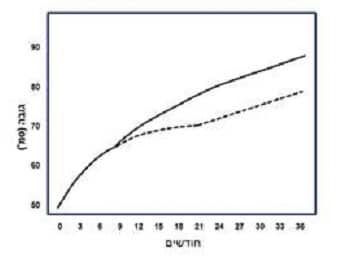This is according to a study conducted by researchers at the Technion, Tel Aviv University and Bnei Zion Hospital in Haifa

When is a person's final height determined? The answer is surprising: it is mostly determined before the age of one year! This surprising fact emerges from an article published in the Journal of Pediatrics. In the pioneering study, in which 162 pairs of twins participated, it was found that the most important element in determining a person's future height is the environment in which he lives in the first year of his life. The study was conducted at the Technion, Tel Aviv University and Bnei Zion Hospital, in collaboration with the health bureaus in Haifa and Tel Aviv.
The researchers' conclusion, according to this study and previous studies led by Professor Zeev Hochberg of the Rappaport Faculty of Medicine at the Technion, is that a person's final height is determined to a large extent (50%) by the conditions of growth in the womb and in the first year of life. Although genetics have a substantial effect on a person's height, the influence of the environment is enormous. When an environment includes the following factors: the course of pregnancy, the diet and the state of health in the first year of life, the parents and the family structure, the economic and emotional situation.
"Following the genetics revolution, it is now customary to attribute a lot of weight to our genes in determining our traits," explains Professor Hochberg. "Indeed, there is no doubt that many of our traits are innate or genetic. However, as can be seen in our research, environmental conditions play a very significant role in determining these traits."
In the research of Professor Hochberg and his colleagues, the relative weight of the various factors that determine the variation in the height of an adult person was examined. The range of difference that exists between tall and short people is about 24 cm, and in the current study it was found that half of this difference is due to congenital genetic factors, and half - to environmental conditions. The researchers focused on the crucial stage, which is the stage of transition from growing a baby to growing a child (age 10.5 months, on average in Israel). They followed this transition phase and its consequences among 162 pairs of twins - 56 pairs of identical twins (that is, with the same genes), 106 pairs of non-identical twins (with different genes), and 106 pairs of non-twin siblings.
"Twin studies make it possible to examine the 'balance of power' between genetics and environment," explains Professor Hochberg. "And here we discovered the enormous power of the environment in shaping man. This is actually the 'plasticity' of development, which means that environmental conditions such as nutrition, weather and social and family situation affect our physical features. From the evolutionary point of view, plasticity 'settles' us features that will help us in our future living conditions, and it 'predicts' these future conditions based on the present conditions. Hence, children born and raised in an environment characterized by hunger will be shorter, so that they will need less food in the future. A rich and satiated environment, on the other hand, will 'grow' tall children."

Professor Hochberg's partners in the study are Dr. Alina German from Bnei Zion Hospital and Klalit Hospital; Professor Zvi Liebshitz, Dr. Ida Malkin and Dr. Inga Peter from Tel Aviv University; Dr. Yonatan Dubnov and Dr. Hana Akons from the Health Bureau in Haifa, and Dr. Michael Shmoish from the Loki Center at the Technion.

12 תגובות
Bila Yasba Yehal سشيتلبل هنقتف بالباهالب باهلا سيبا يبياهاب Ayab Abbasi.
Well done!
I liked what you wrote
health insurance
Low birth weight and thin babies are prone to diseases in their adulthood
Mental stress of the pregnant mother affects the mental state of the fetus in adulthood
Air pollution harms the development of the fetus
And more
Investing in the health of the mother before she becomes pregnant and in the health of the newborn until he grows up in his tender years will prevent many diseases in his adult life and save the country a lot of money
And smoking is known to be harmful in every respect (poor quality of life), and causes the greatest reduction in life expectancy (more than effects: nutrition, physical activity, stress, etc.). The only one who benefits from smoking is the manufacturer…
Can also add to what was said, that smoking, due to its diffusion power into the blood through the lungs, manages to cause considerable damage to all body systems. Especially in the first year as the years progress the damage gets smaller as the limb faces it.
Now all that remains is to check what the basketball players ate and there will be no more short people
Yigal
You are wrong. Smoking is known to impair growth. Read here – http://www.cbc.ca/news/technology/smoking-won-t-help-teens-lose-weight-may-stunt-growth-study-1.718537
Speaking of smoking, it is only known that pregnant smokers give birth to a low birth weight child. Sa Tu.
Friend, I knew that even without research, aha!
Yana
Smoking does affect growth. Smoking increases the concentration of carbon monoxide in the blood, so its ability to transport different substances in the body is smaller. In addition, smoking may lower the concentration of various hormones related to growth, such as testosterone.
The effect of smoking is more than 2 centimeters in height. And that's just smoking, there are other things that affect growth during puberty.
Miracles
In the article we mentioned that the influence of the environment is important in the first year of a baby's life and it determines what the final height will be together with genetics, regardless of what you do in puberty. Of course, a healthy lifestyle affects everything.
Yana
Definately not. Perhaps most of the influence is genetic, but in the case of Prussia there is an environmental influence. I don't know about smoking, but diet and health certainly have an effect.
There are enough good reasons not to smoke... the damage is proven, and serious.
So all the statements that smoking at the age of 15 to 20+ can cause stunting are not true.